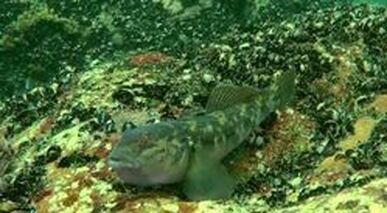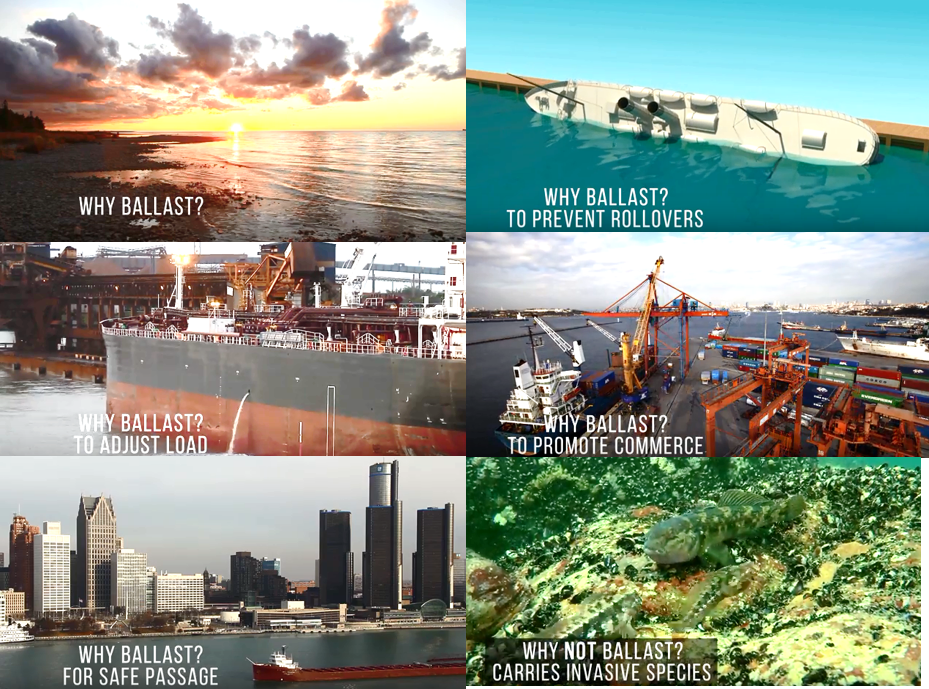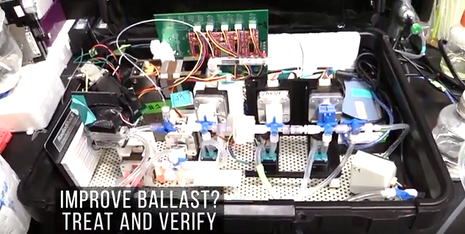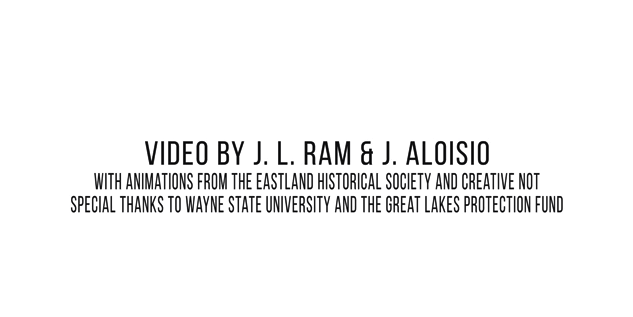
Creating Stories for Science or Engineering Videos
By Jeffrey Ram
Click on image to download a printable version of this lesson plan
We would greatly appreciate your feedback! Click here to complete a short survey telling us about your experience with this lesson plan.
By Jeffrey Ram
Click on image to download a printable version of this lesson plan
We would greatly appreciate your feedback! Click here to complete a short survey telling us about your experience with this lesson plan.
Lesson overview
Students will learn vocabulary about storytelling and through this storytelling vocabulary learn about the most challenging aspect of making a video: Creating an engaging story that is short and effectively conveys a message. Students will watch a short video, identify aspects of it that support their understanding of storytelling vocabulary (video, story, setting, characters, plot, conflict, theme, and solution) and the environment (environment, invasive species, cargo ship, ballast water). They will practice using these words and thinking about these concepts by reading a short story in English, using the “jigsaw” technique, and then they will begin creating a new story about the environment, using their concepts of setting, character, plot, conflict, theme, and solution.
Reference material and background:
Elements of story-telling are from https://blog.pond5.com/6477-storytelling-101-the-6-elements-of-every-complete-narrative/
and notes from participating in videography story-telling activities by Dr. Jeffrey Ram (consult Dr. Ram at [email protected] for details). Information about invasive species can be obtained from the Belle Isle Aquarium STEM web site, at https://www.biaquariumstem.org/educating-about-invasive-species.html. Information about effects of plastics on sea turtles can be obtained from educators at the Belle Isle Aquarium.
Target age: 11 – 14 years old.
Subject: cross-curricular. English and Science/Engineering
Duration: One class period (40 min). Within 40 min they should get to the part of the lesson where they begin creating a new story as a class. This lesson could be followed by students creating their own stories as a homework assignment and then having another lesson in which several stories will be selected for further development as videos.
Instructional setting: Classroom
Learning objectives
At the end of the lesson, the students will be able to:
Materials
Video projector or television and computer (with internet, if possible, but not necessary)
The YouTube video entitled “Why Ballast” (https://www.youtube.com/watch?v=79zJJ7_3oDc&t=7s )
A handout with each of the main images of the “Why Ballast?” video
The short story by Dr. Ram and Dion Walker, entitled “A day at the beach”
Teacher’s guide to the vocabulary
---------------------------------------------------<>------------------------------------------
New vocabulary:
video
story
setting
characters (hero, villain, victim)
conflict
theme
solution
environment
invasive species
cargo ship
ballast water
---------------------------------------------------<>------------------------------------------
Lesson activities:
5E teaching model:
Engagement: The teacher will engage the students interest with an actual video and a short story that have environmental themes. Explaining why video and short story interests them will require them to understand key concepts of storytelling and the environment.
Explore: The “data” for the lesson are the video and short story. The students will analyze both to identify the elements described by the vocabulary words.
Explain: The students will explain why they think various elements apply. For example, they will easily explain the settings, but more complex explanations may occur to explain characters and plot.
Elaborate: The students will use their new knowledge to begin storytelling themselves
Evaluate: The students will write their own stories which the teacher (Anna Maria Ceccarreli) will review. Perhaps the students may also be tested after studying for ability to spell, define, and use the vocabulary words in a sentence.
Safety considerations: None.
---------------------------------------------------<>------------------------------------------
Materials for students: vocabulary list, storyboard for "Why ballast?" and the short story "A Day at the Beach"
Vocabulary:
video
story
setting
characters (hero, villain, victim)
conflict
theme
solution
environment
invasive species
cargo ship
ballast water
Students will learn vocabulary about storytelling and through this storytelling vocabulary learn about the most challenging aspect of making a video: Creating an engaging story that is short and effectively conveys a message. Students will watch a short video, identify aspects of it that support their understanding of storytelling vocabulary (video, story, setting, characters, plot, conflict, theme, and solution) and the environment (environment, invasive species, cargo ship, ballast water). They will practice using these words and thinking about these concepts by reading a short story in English, using the “jigsaw” technique, and then they will begin creating a new story about the environment, using their concepts of setting, character, plot, conflict, theme, and solution.
Reference material and background:
Elements of story-telling are from https://blog.pond5.com/6477-storytelling-101-the-6-elements-of-every-complete-narrative/
and notes from participating in videography story-telling activities by Dr. Jeffrey Ram (consult Dr. Ram at [email protected] for details). Information about invasive species can be obtained from the Belle Isle Aquarium STEM web site, at https://www.biaquariumstem.org/educating-about-invasive-species.html. Information about effects of plastics on sea turtles can be obtained from educators at the Belle Isle Aquarium.
Target age: 11 – 14 years old.
Subject: cross-curricular. English and Science/Engineering
Duration: One class period (40 min). Within 40 min they should get to the part of the lesson where they begin creating a new story as a class. This lesson could be followed by students creating their own stories as a homework assignment and then having another lesson in which several stories will be selected for further development as videos.
Instructional setting: Classroom
Learning objectives
At the end of the lesson, the students will be able to:
- Spell, define, and use properly in a sentence the 6 key elements of a story
- Explain what the environment and invasive species are
- Write a short story in which students can identify the setting, characters, plot, conflict, theme and solution.
Materials
Video projector or television and computer (with internet, if possible, but not necessary)
The YouTube video entitled “Why Ballast” (https://www.youtube.com/watch?v=79zJJ7_3oDc&t=7s )
A handout with each of the main images of the “Why Ballast?” video
The short story by Dr. Ram and Dion Walker, entitled “A day at the beach”
Teacher’s guide to the vocabulary
---------------------------------------------------<>------------------------------------------
New vocabulary:
video
story
setting
characters (hero, villain, victim)
conflict
theme
solution
environment
invasive species
cargo ship
ballast water
---------------------------------------------------<>------------------------------------------
Lesson activities:
- Show 75 second video “Why ballast?”
- Introduce the topic of making videos: “What did we just see?” (A video—this is the first vocabulary word). Ask: What do you need to make a video? (they will say a camera, but the question is “what else?” – “a story” should be the eventual conclusion)
- Discuss with class each of the vocabulary words (written on whiteboard prior to class) that are the key elements for telling a story, referring each element to the “Why Ballast?” handout.
- “Jigsaw” activity: Read the short story “A day at the beach” with each student in the class successively reading one sentence. Ask them to write in their journals or circle in the story what they see as each key element. Briefly discuss, reinforcing the meaning of each vocabulary word.
- Ask class: What story do you want to write for a video? Start with “theme” and progress as far into the story elements as possible.
- Homework assignment: write your own story (or finish up the class’ story), thinking about how it would look in a video.
5E teaching model:
Engagement: The teacher will engage the students interest with an actual video and a short story that have environmental themes. Explaining why video and short story interests them will require them to understand key concepts of storytelling and the environment.
Explore: The “data” for the lesson are the video and short story. The students will analyze both to identify the elements described by the vocabulary words.
Explain: The students will explain why they think various elements apply. For example, they will easily explain the settings, but more complex explanations may occur to explain characters and plot.
Elaborate: The students will use their new knowledge to begin storytelling themselves
Evaluate: The students will write their own stories which the teacher (Anna Maria Ceccarreli) will review. Perhaps the students may also be tested after studying for ability to spell, define, and use the vocabulary words in a sentence.
Safety considerations: None.
---------------------------------------------------<>------------------------------------------
Materials for students: vocabulary list, storyboard for "Why ballast?" and the short story "A Day at the Beach"
Vocabulary:
video
story
setting
characters (hero, villain, victim)
conflict
theme
solution
environment
invasive species
cargo ship
ballast water
Storyboard for "Why Ballast?"
“A Day at the Beach” by Jeffrey L. Ram and Dion N. Walker
This short story has 6 paragraphs and about 15 sentences in it.
“I could watch videos on the internet all day” exclaimed Malia to her friend Eric. “The stories about nature always excite me. Someday I’d like to make my own video but I can’t think of an idea.”
Eric was bored with this topic; he loved the outdoors, not staring at a computer screen. He answered, “That sounds like too much work. Let’s just go to the Belle Isle beach!” What a character!
From a distance the beach looked beautiful, but when they arrived, they found it covered with plastic bottles and bags and fragments of plastic of every shape and color, washed ashore by the last storm. Then they saw it: a large turtle whose head was stuck in a plastic Faygo pop bottle. The turtle was starving.
Eric was heart-broken to see the turtle struggle, but Malia took charge. “Let’s go to the Belle Isle Aquarium and see if they can help.”
Ten minutes later, Denzel and Sandra, two scientists from the Wayne State laboratory at the Aquarium, were observing Michelangelo, the name they had given the turtle, in their microscope. “Our veterinarian will have Michelangelo cleaned up, fed the right food, and back to the Detroit River so soon he’ll think he was just on holiday.”
That’s when Malia knew what her video would be about: “Michelangelo’s Recovery.” Its theme would be “plastics are a problem” and the solution would not be curing turtles but keeping plastics out of our lakes and rivers so turtles wouldn’t eat or get tangled in them in the first place. Eric was convinced; even he would help.
This short story has 6 paragraphs and about 15 sentences in it.
“I could watch videos on the internet all day” exclaimed Malia to her friend Eric. “The stories about nature always excite me. Someday I’d like to make my own video but I can’t think of an idea.”
Eric was bored with this topic; he loved the outdoors, not staring at a computer screen. He answered, “That sounds like too much work. Let’s just go to the Belle Isle beach!” What a character!
From a distance the beach looked beautiful, but when they arrived, they found it covered with plastic bottles and bags and fragments of plastic of every shape and color, washed ashore by the last storm. Then they saw it: a large turtle whose head was stuck in a plastic Faygo pop bottle. The turtle was starving.
Eric was heart-broken to see the turtle struggle, but Malia took charge. “Let’s go to the Belle Isle Aquarium and see if they can help.”
Ten minutes later, Denzel and Sandra, two scientists from the Wayne State laboratory at the Aquarium, were observing Michelangelo, the name they had given the turtle, in their microscope. “Our veterinarian will have Michelangelo cleaned up, fed the right food, and back to the Detroit River so soon he’ll think he was just on holiday.”
That’s when Malia knew what her video would be about: “Michelangelo’s Recovery.” Its theme would be “plastics are a problem” and the solution would not be curing turtles but keeping plastics out of our lakes and rivers so turtles wouldn’t eat or get tangled in them in the first place. Eric was convinced; even he would help.
Teacher
1. Definitions of vocabulary words:
Video: a recording of moving visual images
Story: a description, either true or imagined, of a connected series of events
Setting: the time and place of a story
Characters: the people or objects that interact or change in a story
Plot: the sequence of events that lead the audience to the point of the story
Conflict: a struggle between characters
Theme: the overall message of the story
Solution: How the problem created by the conflict was solved
Environment: the air, water, and land around us (note: it is not only “nature,” the environment includes everything in, under, and around the city, too)
Invasive species: a plant or animal from another place that causes harm to the environment or people
Cargo ship: a large boat that can carry people or goods from one harbor to another, even across the oceans
Ballast water: water that is pumped in and out of a ship to keep it balanced
2. Story-telling elements in “Why Ballast?” and “A Day at the Beach”
“Why Ballast?”
Setting: the ship in a river or lake
Characters: villain: invasive species victim: environment hero: treatment and verification system
Plot: ships need ballast to be safe and prevent rollovers; also to adjust for different amounts of cargo in support of trade and business
Conflict: ballast also carries invasive species (bad!)
Theme: How to make ship ballast safe for the environment
Solution: Treat and verify ballast does not have invasive species, to keep ships safe and protest the environment
“A Day at the Beach”
Setting: In front of a video screen; then at the beach
Characters: Maria, Enrico, Enzio (the turtle), plastics. Enzio is clearly the victim and plastics are the villain. But who is the hero? I think Maria who thinks to call the scientists. The scientists, Sandra and Fulvio, could also be considered heroes. Enrico is a supporting character who helps the plot move along.
Plot: instead of watching nature videos and making her own, Maria goes with Enrico to the beach and sees a real problem in nature
Conflict: Plastics make a turtle sick
Solution: Maria finds scientists who can save the turtle and also gets an idea for making a video.r’s guide:
1. Definitions of vocabulary words:
Video: a recording of moving visual images
Story: a description, either true or imagined, of a connected series of events
Setting: the time and place of a story
Characters: the people or objects that interact or change in a story
Plot: the sequence of events that lead the audience to the point of the story
Conflict: a struggle between characters
Theme: the overall message of the story
Solution: How the problem created by the conflict was solved
Environment: the air, water, and land around us (note: it is not only “nature,” the environment includes everything in, under, and around the city, too)
Invasive species: a plant or animal from another place that causes harm to the environment or people
Cargo ship: a large boat that can carry people or goods from one harbor to another, even across the oceans
Ballast water: water that is pumped in and out of a ship to keep it balanced
2. Story-telling elements in “Why Ballast?” and “A Day at the Beach”
“Why Ballast?”
Setting: the ship in a river or lake
Characters: villain: invasive species victim: environment hero: treatment and verification system
Plot: ships need ballast to be safe and prevent rollovers; also to adjust for different amounts of cargo in support of trade and business
Conflict: ballast also carries invasive species (bad!)
Theme: How to make ship ballast safe for the environment
Solution: Treat and verify ballast does not have invasive species, to keep ships safe and protest the environment
“A Day at the Beach”
Setting: In front of a video screen; then at the beach
Characters: Maria, Enrico, Enzio (the turtle), plastics. Enzio is clearly the victim and plastics are the villain. But who is the hero? I think Maria who thinks to call the scientists. The scientists, Sandra and Fulvio, could also be considered heroes. Enrico is a supporting character who helps the plot move along.
Plot: instead of watching nature videos and making her own, Maria goes with Enrico to the beach and sees a real problem in nature
Conflict: Plastics make a turtle sick
Solution: Maria finds scientists who can save the turtle and also gets an idea for making a video.r’s guide:

Creation of the above page of educational resources was funded in part by the Michigan Invasive Species Grant Program through the Departments of Natural Resources, Environmental Quality, and Agricultural and Rural Development.
This material is also based upon work supported by the National Science Foundation under Grant No. 1614187.
Any opinions, findings, and conclusions or recommendations expressed in this material are those of the authors and do not necessarily reflect the views of the National Science Foundation.


